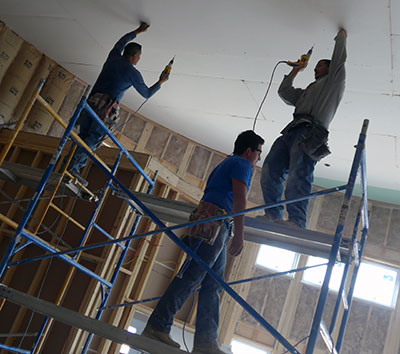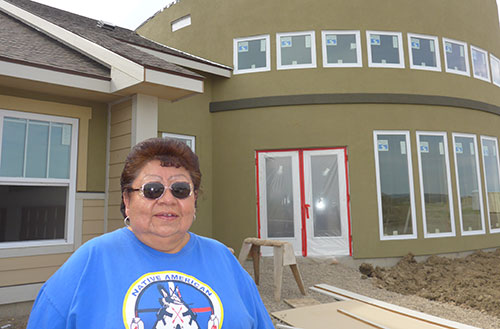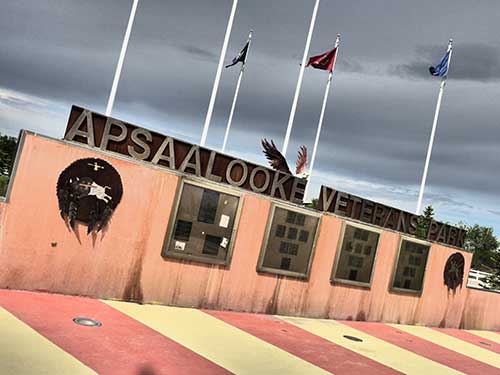
By Elizabeth Zach, RCAC staff writer
On the windy plains of the Crow Reservation in southern Montana, young men scramble across scaffolding amid massive fans and turbines, measuring door widths and sweeping the cement floors across this dusty construction site.
Mary L. LaForge walks the halls of the building’s skeleton, pointing into doorways that will one day open into airy apartments.
“We’re getting there, slowly, and we’re proud of how it’s coming along,” she says as she gazes out of the windows toward boarded up houses and a cemetery.
The soon-to-be Apsaalookè Warrior Apartments (AWA) complex here is small, but that was by design because this is a trial effort. It includes 15 apartments and office space, and could be any multi-functional building in any town or city in the nation. But these apartments will eventually be home to people who, it could be argued, need it the most: homeless Native American war veterans. The office space, too, will respond to a host of needs neglected for many years, such as benefits counseling and healthcare referrals.
In 2010, the Veterans Administration crafted Opening Doors, an ambitious and far-reaching plan to finally house the nation’s 50,000 homeless veterans by the end of this year.
The plan rests on the Housing First approach, whereby housing advocates seek to house homeless people as quickly as possible and then provide healthcare or drug and alcohol treatment services as needed. Prior to 2010, which is when housing advocates adopted the concept, the VA had focused on transitional housing, and offered limited services. According to the U.S. Department of Veteran Affairs, which reviewed Opening Doors’ progress in 2014, the number of homeless veterans is down by 33 percent since 2010. And VA officials are optimistic they will meet their 2015 goal.

For Native Americans, this initiative is particularly significant. As Gen. Douglas MacArthur once put it, if all Americans served in the Armed Forces at the same rate as Native Americans, there would never be a need for a draft. In 2013, the Veteran’s Administration released a survey of Native Americans in the military, and found that Native American females serve at a higher rate per capita than any other ethnic group. And in the post-9/11 period, Native Americans serve at a higher percentage than veterans of other races, the VA found: 18.6 percent versus 14 percent, respectively.
Out of a total population of 13,000 on the Crow reservation, 250 are registered veterans, says LaForge, a Veteran Tribal Outreach Worker. As many as 50 veterans and active military personnel live off the reservation. In recognition of this service, the Department of Veterans Affairs in April awarded $1.2 million to Montana’s Crow Tribe to establish a veterans’ cemetery in Crow Agency, the largest town on the reservation.
The $2.5 million AWA housing project is funded in part by equity from the sale of low-income housing tax credits and also an Affordable Housing Program (AHP) grant sponsored by First Interstate Bank. According to Paul Little Light, who, together with LaForge helped launch the project, it serves as an innovative model for housing not only Native American veterans, but homeless veterans in general. The office space will accommodate staff from the Tribal Department of Health and Human Services who will offer courses in financial literacy, and will provide case management, credit counseling, and post-traumatic stress disorder counseling. On-site computers will enable residents to follow or check their e-benefits.
On June 22, the Crow Housing Authority began accepting applications from qualified veterans and by the end of the week, had received 10. But Little Light says interest in the apartments is strong and, “We expect an overflow of applications. “

He added that the housing is aimed at veterans of the wars in Korea and Vietnam, and rents will be set at 30 percent of a tenant’s monthly income. We’re not going to be able to help everyone.”
To make the apartments a reality, Little Light joined forces with Zoe LeBeau, President of LeBeau Development LLC, who works with Tribes on supportive housing throughout the nation, and housing developer Blue Line, Inc. To finance the complex’s infrastructure, labor and machinery, Little Light prepared an Innovative Readiness Training (IRT) application with assistance from California-based Walking Shield Inc., which works with the Department of Defense on programs related to veteran shelter and healthcare. Housing materials from homes being torn down on Malmstrom Air Force Base in Montana were also brought to the project. With everything in place for construction, a VISTA volunteer was recruited to develop a service plan for the veterans at the AWA.
“This was the fastest supportive housing project I’ve ever worked on,” said LeBeau. “The Tribe was completely dedicated to getting this done, and had all the right people and departments at the table.”
Both Little Light and LaForge are veterans themselves. LaForge served in the U.S. Air Force from 1977 until 1983; and Little Light served in the U.S. Army from 1995 until 1998.
